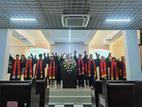The impact of the new coronavirus pandemic on the world is huge in all aspects, while the social environment of churches has also changed much. Let us take a city church as an example.
The pandemic changed the number of worship services.
In the past, there was only one service on Sunday, and on several occasions, the leaders of this church discussed about increasing the number of services, but the idea was not implemented.
However, when the suspended gatherings resumed, they strictly controlled the number of churchgoers which was only one-third of the number before the pandemic, but the number of Sunday services increased from one to four. As the pandemic situation improved, the number of worshippers increased correspondingly in each service, and the number of worship sessions only decreased by one. Thanks to the pandemic, the increased number of worship sessions became a new reality, which aligned with the idea that they had earlier on but could not implement. This not only addressed the needs at the time, but also left room for follow-up development.
The pandemic changed the way gatherings are held.
Before the pandemic, the faithful mostly worshipped in the church, and online gatherings were unimaginable, although there were many church WeChat groups at the time, which were all for the convenience of communication.
After the outbreak of COVID-19, gatherings were suspended and communication between people was strictly restricted, which made gatherings and visitation difficult. So the church began to encourage believers to hold family worship and implement online pastoral care to meet special needs. Although churches have begun to resume gatherings for some time now, online gatherings did not completely stop, as they have become a useful supplement to in-person gatherings.
The pandemic changed the composition of the congregation.
In the past, this was a typical "four-generation" church, with the elderly, the middle-aged, the young and the kids. Moreover, these groups had specific services in the church, and even separate gathering places. However, after the outbreak of COVID-19, out of the need for prevention and control of pandemic, people including the elderly, the weak, the sick, the pregnant and the children could not attend the service and receive pastoral care. Hopefully, this situation will return to normal when the pandemic dies down.
The pandemic impacted the spiritual lives of believers and their enthusiasm for gathering.
Let us start with the changes in the lives of believers, which comprised joys and worries according to the observations. Fortunately, some believers still kept online and in-person gatherings during the pandemic, continually pursuing the Lord. And they also learned more lessons from the pandemic, which enabled their lives to grow. What worried us was that some believers left the church and turned away from God, as they stopped gathering due to the novel coronavirus.
Some of them were not as enthusiastic about gathering as they used to be because of the suspension of services. Even if the church reopened, they had no motivation to attend services again. Others were accustomed to online gatherings, so they found it troublesome to go to church to worship, because online gatherings also had God's presence. This phenomenon was more common in the early stage, but it fortunately changed later on, because believers could really find that in-person gatherings were indeed better than online ones.
In fact, the above-mentioned are only a few visible changes. There are also other invisible, uncounted and internal changes, which need to be covered.
(The author is a pastor in Jiangsu Province and the article is published by Gospel Times.)
- Translated by Abigail Wu












